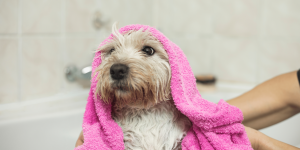How to Bath Your Dog At Home.
Lots of dogs love water, but when it comes to bath time, many of them are not quite as happy about the prospect of an unceremonious dunking! Holidays4Dogs provides some hints and tips on making canine bath time a little less chaotic for everyone.
Its good to know that, while dogs need grooming regularly, they don’t really need bathing very often. In fact, bathing too much can strip valuable oils from your dog’s coat and cause dandruff. There’s no need for weekly, or even monthly baths unless this is part of managing a medical condition, such as skin allergies.
However, it is fair to say that – how frequently you need to bath your dog, depends on how much time he spends rolling in obnoxious substances. After all, nobody wants to live with a stinky dog.
Select the correct shampoo.
While it may be tempting to just use your own shampoo when you bath your dog, this is not advised. Human shampoos can cause irritation to a dog’s skin because they have a different pH level to humans. As a result, shampoo meant for humans can damage the very top layer of canine skin without keeping it hydrated. This can then leave the skin open to bacterial infection and parasites.
Prepare everything you need.
Gather everything you need beforehand. There is nothing worse than having a sopping wet dog, only to find you can’t reach the towels. If you are bathing your dog indoors, you may want to remove any of your own towels, or bathmats, so they don’t get wet or dirty.
In the summertime you could shower, or bath, your dog outdoors using a baby bath, paddling pool, or hosepipe. If the weather is very hot, your dog may appreciate having a cool bath anyway.
You can also purchase baths specifically for dogs, that can be used outdoors, or in a utility room/garage. You can also buy portable pet washers, which are particularly useful after a muddy dog walk.
Just be aware – if you’re bathing your dog outdoors, don’t let your dog loose until he is completely dry.
Many dogs will get the ‘zoomies’ after a bath and will immediately run around rubbing themselves on the ground.
Outdoors, this may mean rubbing themselves in soil and dirt in an attempt to rid themselves of soapy smells.
Rub-a-dub-pup – tips
When bathing your dog indoors place a rubber mat, or old towel, in the bottom of the bath. This will help stop your dog from slipping. Many dogs don’t like the feel of a slippery surface and may panic. A towel will also protect the surface of your bath tub.
Put water in the bath, before you put the dog in. Some dogs are nervous of water gushing loudly from the taps. Don’t over fill the bath – a few inches will do. Place your dog gently in the bath and give him plenty of reassurance.
You can either use a jug to pour water over your dog, or use a spray attachment from the taps.
If your dog is a wriggler, you may need someone else to help steady him in the bath.
Make bath time as pleasant for your dog as you can. Gently massage shampoo into his coat with soft circular movements, leaving the face area out.
When rinsing, be careful not to get any water in your dogs eyes – use a face cloth instead to cleanse this area.
Only use products meant for dogs to bath your pooch in. Human shampoos can cause irritation to a dog’s skin.
When you have finished, your dog will naturally want to shake, so rub him down really well. Drape a small towel loosely over his head, as this will delay his shaking reaction.
Give him plenty of praise and some tasty treats once the job is done.
Conclusion.
Some dogs are happy to be dried with a hair dryer, but for others, this will simply add insult to injury. If you have a crate you could place him in that for a short while until he dries off completely. This will stop him from attempting to dry himself off on your carpets, or couch.
As long as you approach bath time with lots of positive reinforcement and and a matter-of-fact, bath time can be less of a palaver for both you – and your dog.
Holidays4dogs.co.uk and 4Dogs are participants in the Amazon Services LLC Associates Program, an affiliate advertising program designed to provide a means for sites to earn commission fees by advertising and linking to the following websites. Read our full disclosure agreement here https://www.holidays4dogs.co.uk/affiliate-disclosure/


